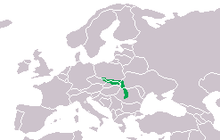Carpathian newt
| Carpathian newt | ||||||||||||
|---|---|---|---|---|---|---|---|---|---|---|---|---|

Carpathian Newt ( Lissotriton montandoni ), male |
||||||||||||
| Systematics | ||||||||||||
|
||||||||||||
| Scientific name | ||||||||||||
| Lissotriton montandoni | ||||||||||||
| ( Boulenger , 1880) |
The Carpathian newt ( Lissotriton montandoni , syn .: Triturus montandoni see: Triturus ) is a tailed amphibian from the family of the real salamanders (Salamandridae).
features
It is a small, graceful newt - adult animals are 80 (rarely 95) in males and up to 100 millimeters in length in females. The head is flat and broad; it has three longitudinal furrows on the top. The males develop two raised lateral back gland swellings in the water, which makes the trunk cross-section appear somewhat rectangular. They also have a thread at the end of their tail (compare: thread newt !) And instead of a comb (compare, for example: pond newt ) form a central back bar that merges into the fin edge of the tail. Their upper side is gray-brown to olive-green and often with dark spots. The lateral head area is darkly colored and interspersed with light spots. The lower caudal fin edge of the males shows a light stripe with dark spots. The belly side is intensely orange-red, sometimes yellowish in color and usually unspotted (compare: mountain newt ). Females as well as young animals often have a bright zigzag pattern on their backs that stand out from the darker, brownish flanks. They have no back bar and lower fin hems. In the more inconspicuous country dress, the previously smooth skin becomes velvety and water-repellent.
distribution
The species occurs naturally only in a relatively small area in the area of the Central-Eastern European Carpathian Arc. The Sudetes (southern edge of Poland and the eastern edge of the Czech Republic ), northeastern Slovakia ( Beskydy , High and Low Tatras ), the western tip of Ukraine with the Forest Carpathians and the Romanian Eastern Carpathians ( Transylvania ) are populated. The vertical distribution ranges from 200 to almost 2000 m - the focus is on the altitude level between 600 and 1200 meters.
In 1901 Carpathian newts were released in the Bavarian Forest and were detected there in 1938 and for the last time in 1950.
Habitat and way of life
The main habitat are coniferous and deciduous forests of the Carpathian Mountains. Here the newts hide under stones, piles of brushwood and the like during the day. At night they hunt for insects , woodlice , spiders and worms ; Small crustaceans and insect larvae are the main prey in the spawning waters . After the hibernation, which lasts from October / November to March / April and is spent terrestrially in frost-proof places , the newts migrate to the breeding waters in late spring. At lower altitudes these are rather cool, shady ponds, at higher altitudes they are small ponds that warm up more quickly.
Reproduction
During courtship in the water, the male woos a female in typical pigging manner - there are special parallels to the behavior of the closely related species of pond newt and newt . Eventually, it deposits a spermatophore , which the female ingests through the cloaca . This later attaches 35 to 250 eggs individually to aquatic plants.
After 10 to a maximum of 30 days of embryonic development , the larvae hatch and now need about three months to metamorphose into land animals. By then they will grow from six to ten initially to 30 (to 40) millimeters in length. Larvae can develop more quickly in warm shallow waters.
Hazard and protection
Stocks suffer from the pollution and destruction of spawning waters and from artificial fish stocking in small bodies of water.
Legal protection status (selection)
- Habitats Directive : Annexes II and IV (special protected areas are to be designated / species to be strictly protected)
- Federal Nature Conservation Act (BNatSchG): strictly protected
swell
literature
- Günter Diesener & Josef Reichholf: Amphibians and reptiles. Mosaik-Verlag, Munich 1986, ISBN 3-570-01273-5
- Andreas Nöllert, Christel Nöllert: The amphibians of Europe. Kosmos-Franckh, Stuttgart 1992, ISBN 3-440-06340-2
Individual evidence
Web links
- Photos of the Carpathian Newt at www.herp.it
- Lissotriton montandoni inthe IUCN 2013 Red List of Threatened Species . Posted by: Jan Willem Arntzen, Sergius Kuzmin, Natalia Ananjeva, Nikolai Orlov, Boris Tuniyev, Agnieszka Ogrodowczyk, Maria Ogielska, Wiesiek Babik, Dan Cogalniceanu, 2008. Accessed November 20, 2013.

